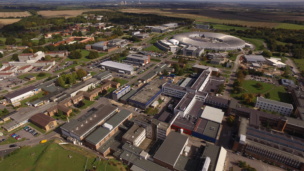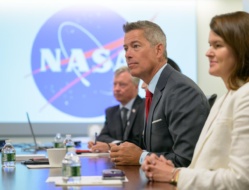Last week, the Defense Innovation Unit (DIU), the Space Force, and the Air Force Research Laboratory released their fourth annual joint report on the state of the space industrial base.
The verdict: The US has a lot of work to do if it wants to compete with China over the long run.
Penned by four prominent Pentagon space officials, the report makes the case for more thoughtful state industrial planning and outlines the role industry should play in that future. Thinking further out and working hand-in-glove with commercial space, the authors believe, will enable the US to move faster.
“While there are isolated bright spots across NASA and DoD, the sense of urgency is not universally shared—especially within the vast bureaucracy that is constructively delaying US commercial progress through regulatory burden,” the authors wrote.
Vision problems
What are we trying to do in space, anyway? Within the DoD, there isn’t a clear nor commonly articulated vision. The report highlights this sin of omission as a vulnerability.
China, on the other hand, has clear plans through at least 2045, and is making its space program a national priority. “China could surpass the US in space superiority if we don’t increase our investment,” DIU director Michael Brown said at an Atlantic Council event last week.
- Last year, China led the world in number of launches (though
SpaceXthe US won on total upmass). - “While the United States space industrial base is on an upward trajectory, participants expressed concerns that the upward trajectory of the [People’s Republic of China] is even steeper, with a significant rate of overtake, requiring urgent action,” the authors wrote.
Drawing inspiration: In 1962, the White House put out a “North Star” vision that affirmed the federal government’s commitment to the Apollo program.
Now, the authors write, we are in a new—don’t say it, don’t say it—space race. The stakes of that race are lasting economic superiority and security in space. Consequently, the report argues, Washington needs a new North Star to unify the government, space industry, and the public toward a set of common goals.
The report’s recommendation for a new North Star goal is the same as what the authors outlined in last year’s report: space development and settlement. The Artemis program and developing the Moon are included in that vision, as well as increasing science and technology funding, reforming policy, declaring a space economic zone, and incorporating space technology into long-term infrastructure plans.
Spurring on industry
The unwieldy machine that is the government procurement system is stepping on the space industry’s toes. The report’s authors call for major changes to the way the DoD and NASA identify new space technologies and ready them for government use.
“What’s required to win the space race is the strengthening of private-public partnerships that emphasize commercial technology over bespoke systems,” Michael Brown, head of the DIU, said at the Atlantic Council event last week.
The report identified a few key sticking points:
- Licensing bodies (including the FAA, FCC, and NOAA) have not expanded to meet the demand for satellite launches, and license applications take too long to review
- Contracting procedures leave little room for innovation and set too many requirements
- Government investment is sporadic
TL;DR: The innovation driving the commercial space industry could have a huge impact on US national security infrastructure, if only the government were prepared to procure that technology. The report echoes the common refrain that a stronger public/private partnership and shared vision is needed to cement the US as the economic leader in space.




